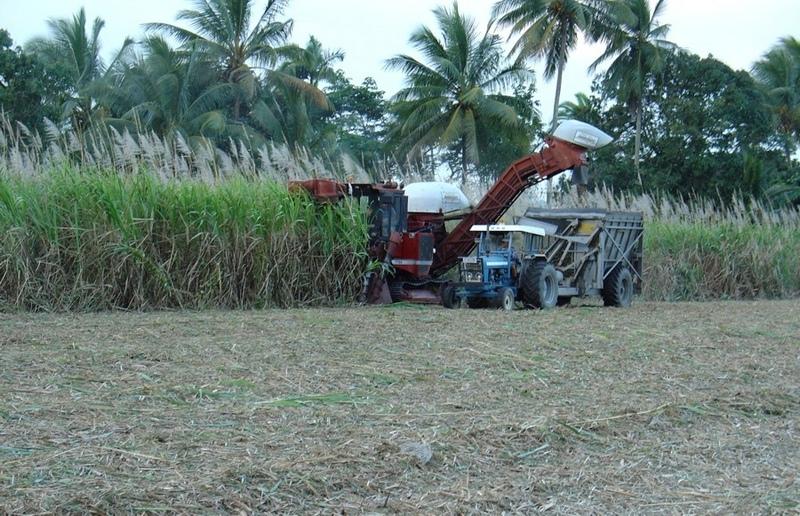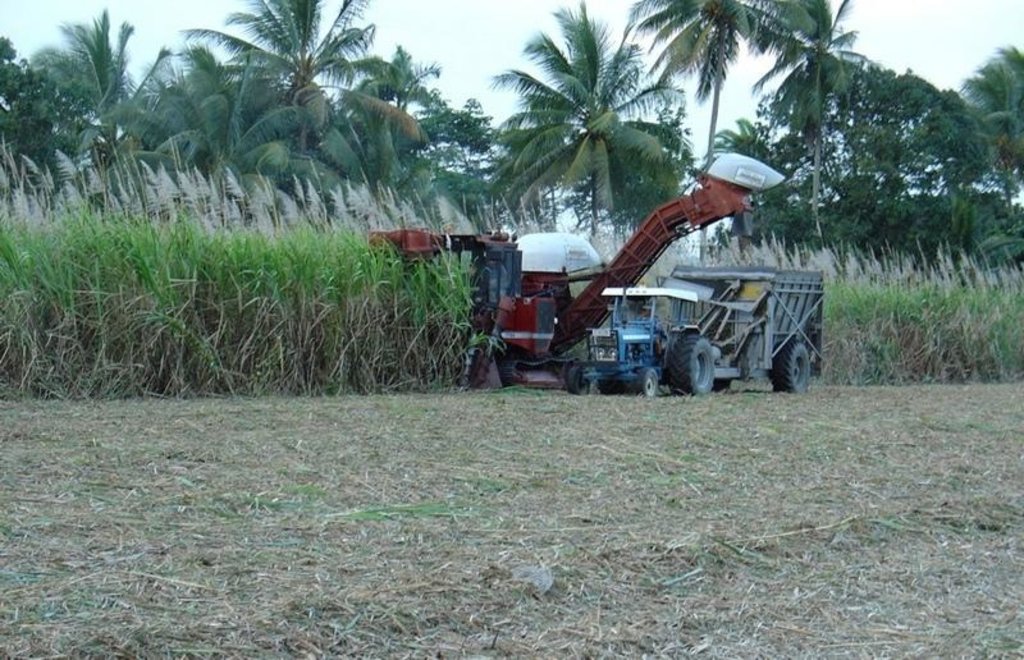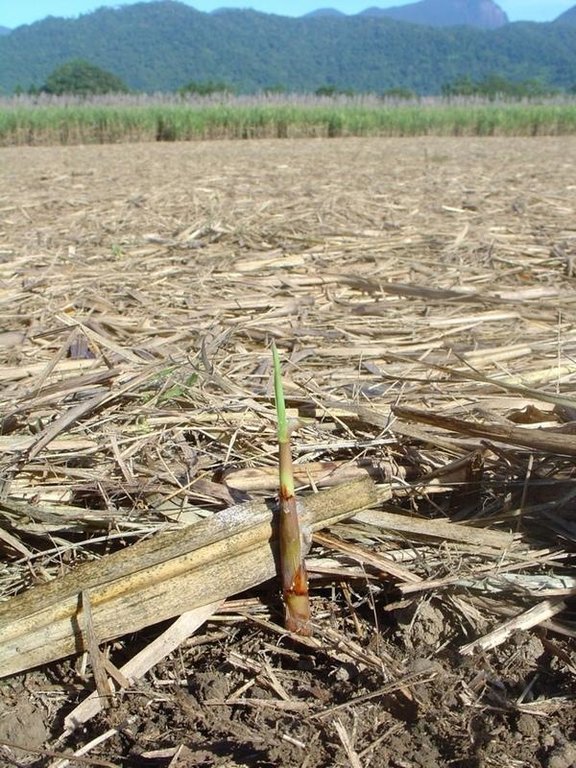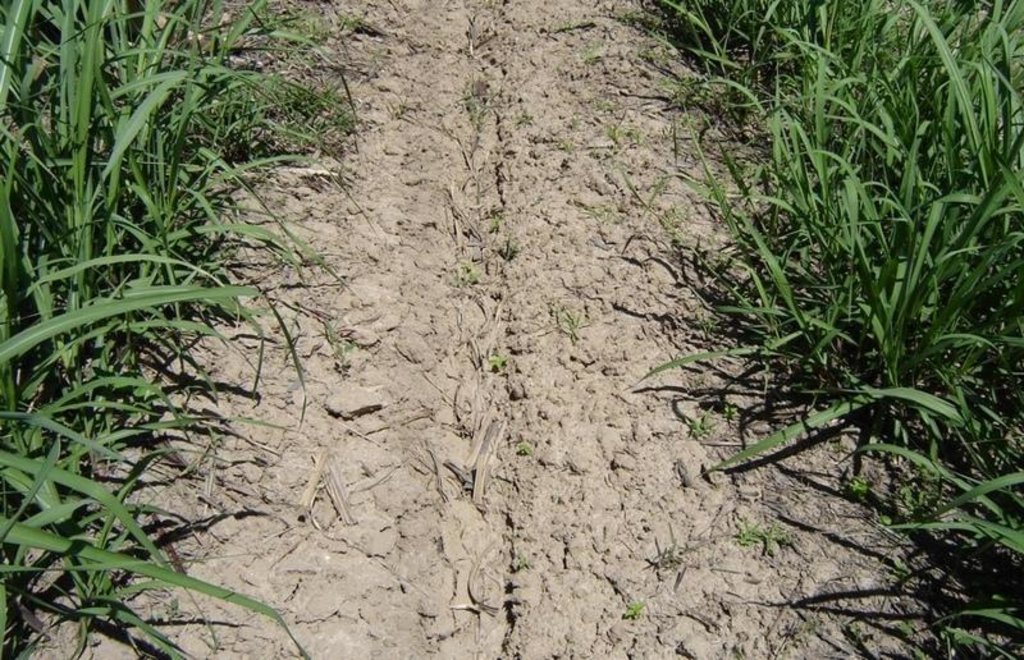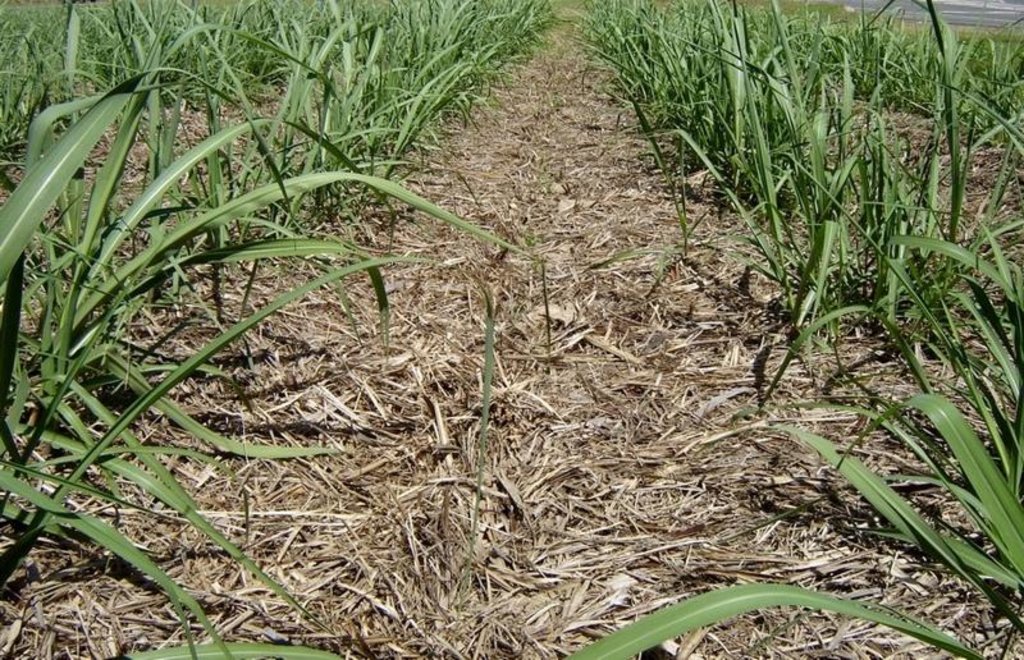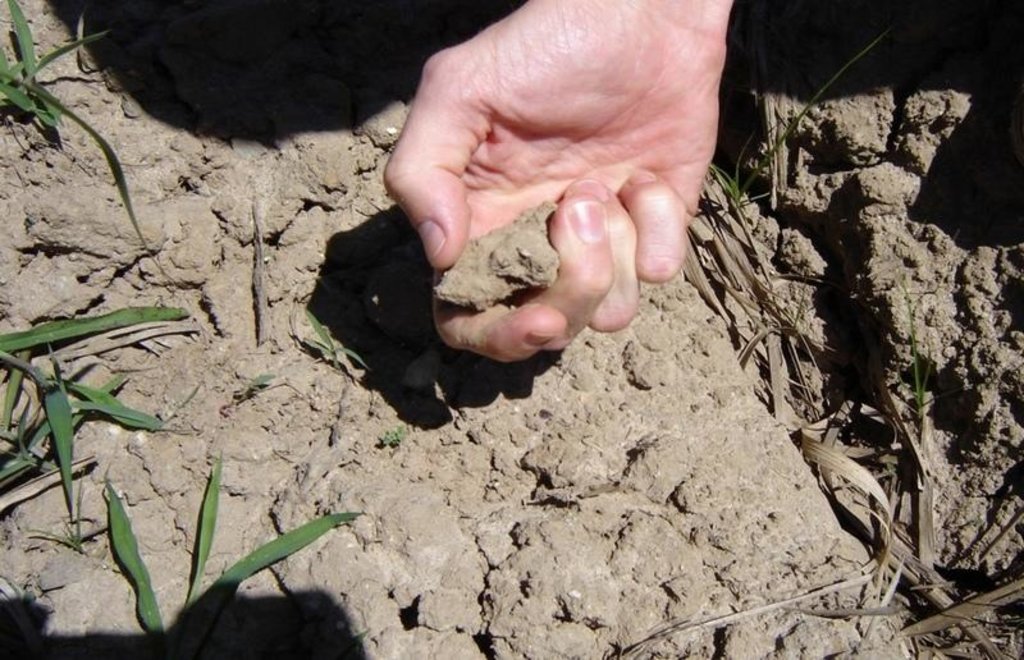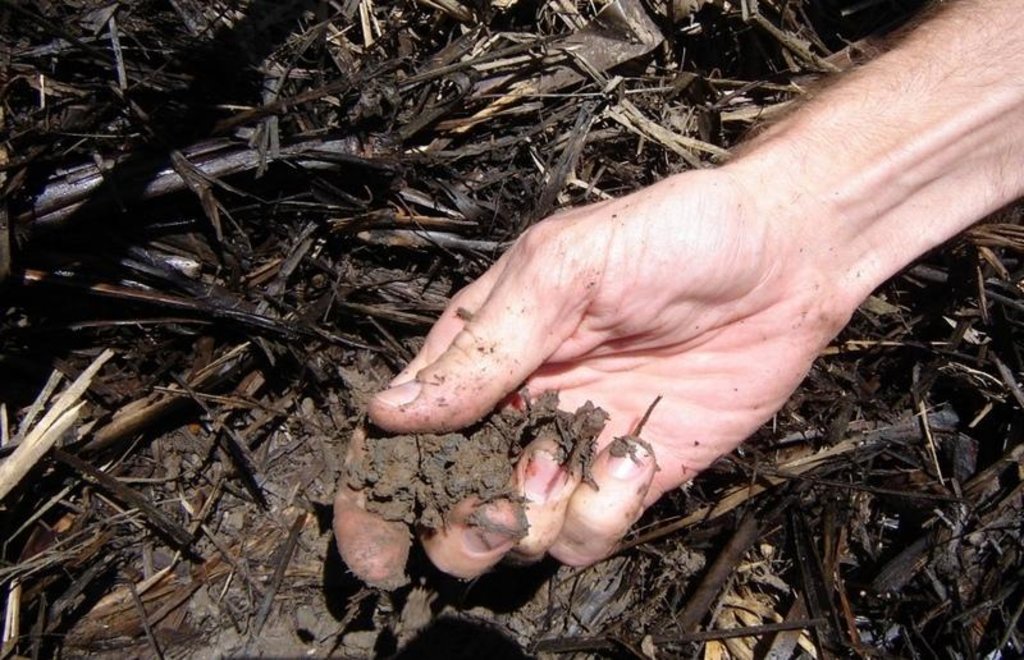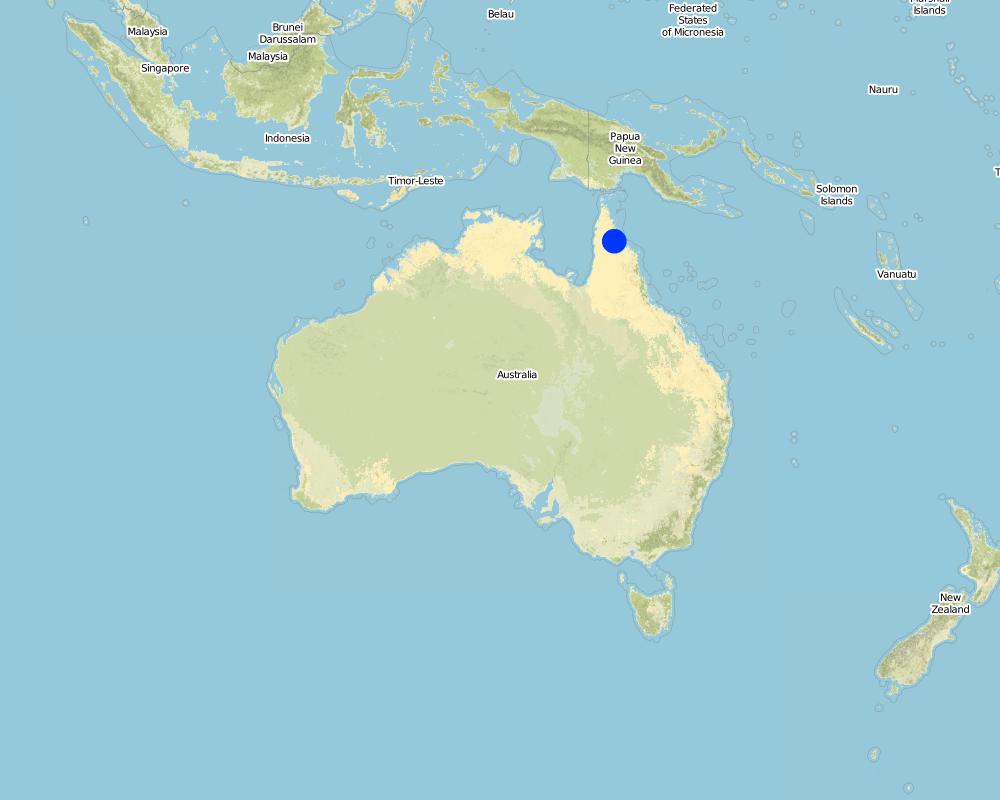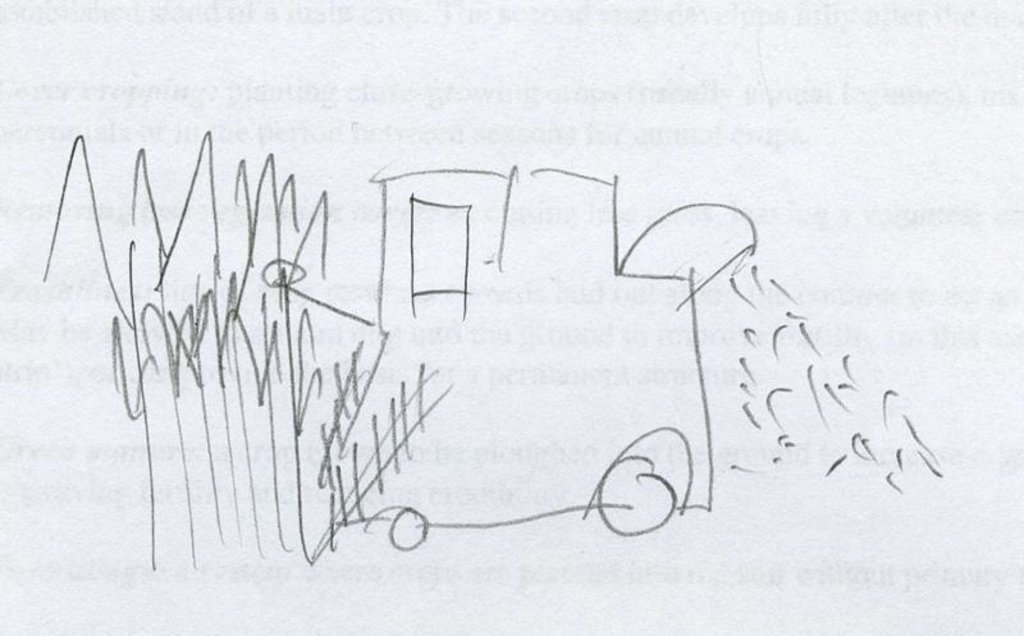Green cane trash blanket [ប្រទេសអូស្ត្រាលី]
- ការបង្កើត៖
- បច្ចុប្បន្នភាព
- អ្នកចងក្រង៖ Anthony J. Webster
- អ្នកកែសម្រួល៖ –
- អ្នកត្រួតពិនិត្យច្រើនទៀត៖ Alexandra Gavilano, Fabian Ottiger
Trash blanket
technologies_951 - ប្រទេសអូស្ត្រាលី
ពិនិត្យមើលគ្រប់ផ្នែក
ពង្រីកមើលទាំងអស់ បង្រួមទាំងអស់1. ព័ត៌មានទូទៅ
1.2 ព័ត៌មានលម្អិតពីបុគ្គលសំខាន់ៗ និងស្ថាប័នដែលចូលរួមក្នុងការវាយតម្លៃ និងចងក្រងឯកសារនៃបច្ចេកទេស
ឈ្មោះគម្រោងដែលបានចងក្រងឯកសារ/ វាយតម្លៃលើបច្ចេកទេស (បើទាក់ទង)
Book project: where the land is greener - Case Studies and Analysis of Soil and Water Conservation Initiatives Worldwide (where the land is greener)ឈ្មោះអង្គភាពមួយ (ច្រើន) ដែលបានចងក្រងឯកសារ/ វាយតម្លៃបច្ចេកទេស (បើទាក់ទង)
CSIRO (CSIRO) - ប្រទេសអូស្ត្រាលី1.3 លក្ខខណ្ឌទាក់ទងទៅនឹងការប្រើប្រាស់ទិន្នន័យដែលបានចងក្រងតាមរយៈ វ៉ូខេត
អ្នកចងក្រង និង(បុគ្គលសំខាន់ៗ)យល់ព្រមទទួលយកនូវលក្ខខណ្ឌនានាទាក់ទងទៅនឹងការប្រើប្រាស់ទិន្នន័យដែលបានចងក្រងតាមរយៈវ៉ូខេត:
បាទ/ចា៎
1.4 សេចក្តីប្រកាសស្តីពីចីរភាពនៃការពណ៌នាពីបច្ចេកទេស
តើបច្ចេកទេសដែលបានពណ៌នានេះមានបញ្ហាដែលផ្តោតលើការធ្លាក់ចុះគុណភាពដី, បើដូច្នេះវាមិនអាចត្រូវបានប្រកាសថាជាបច្ចេកទេសនៃការគ្រប់គ្រងប្រកបដោយចីរភាពទេ?
ទេ
1.5 ការយោងទៅលើកម្រងបញ្ជីសំណួរ (មួយ ឬច្រើន) នៃវិធីសាស្ត្រផ្សព្វផ្សាយ SLM (ដែលបានចងក្រងដោយទស្សនៈពិភពលោកស្តីពីវិធីសាស្ត្រ និងបច្ចេកទេសងអភិរក្ស WOCAT)
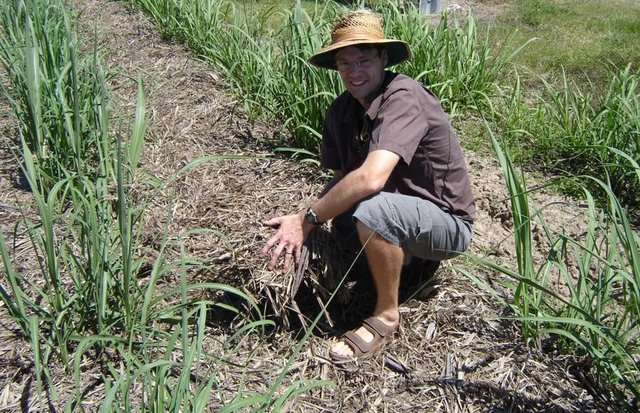
The 'Triple bottom line' [ប្រទេសអូស្ត្រាលី]
A new expression used by agriculturalists in Australia to explain why farmers change practices: the 'triple bottom line' implies economic, environmental and social concerns.
- អ្នកចងក្រង៖ Anthony J. Webster
2. ការពណ៌នាពីបច្ចេកទេស SLM
2.1 ការពណ៌នាដោយសង្ខេបពីបច្ចេកទេស
និយមន័យបច្ចេកទេស:
Elimination of burning as a pre-harvest treatment of sugar cane, and managing the resultant trash as a protective blanket to give multiple on and off-site benefits.
2.2 ការពណ៌នាលម្អិតពីបច្ចេកទេស
ការពណ៌នា:
Under conventional production systems, sugar cane is burnt before being harvested. This reduces the volume of trash - comprising green leaves, dead leaves and top growth - making harvesting of the cane simpler, and subsequent cultivation of the soil easier. In the humid tropics of North Queensland, harvesting of cane used to be carried out by hand - as it still is in many parts of the developing tropics. Burning was necessary to make harvesting possible in a dense stand (and to reduce the danger of snakes). However, with the advent of mechanical harvesters in the 1960s, burning continued to be practiced through habit.
A new system then brought fundamental changes in soil management: The ‘green cane trash blanket’ (GCTB) technology refers to the practice of harvesting non-burnt cane, and trash blown out behind in rows by the sugar cane harvester. This trash forms a more or less complete blanket over the field. The harvested lines of cane re-grow (‘ratoon’) through this surface cover, and the next year the cycle is repeated: the cane is once again harvested and more trash accumulates in the inter-rows. Generally the basic cropping cycle is the same, whether cane is burnt or not. This involves planting of new cane stock (cuttings or ‘billets’) in the first year, harvesting this ‘plant crop’ in the second year, and then in years three, four, five and six taking successive ‘ratoon’ harvests. In year six, after harvest, it is still common, even under the GCTB system, to burn the residual trash so that the old cane stools can be more easily ploughed out, and the ground ‘worked up’ (cultivated) ready for replanting. A minority of planters, however, are doing away with burning altogether, and ploughing in the residual trash before replanting. A further variation is not to plough out and replant after the harvest in year six, but to spray the old cane stock with glyphosat (a broad spectrum non-selective systemic herbicide) to kill it, then to plant a legume (typically soy bean) as a green manure crop, and only replant the subsequent year after ploughing-in the legume. Under this latter system, one year of harvest is lost, but there are added benefits to the structure and nutrient content of the soil.
Whatever variation of GCTB is used, there are advantages in terms of increased organic matter, improved soil structure, more biodiversity (especially below ground) and a marked reduction in surface erosion - from over 50 t/ha to around 5 t/ha on average. Less erosion is good for the growers - but is also of crucial importance off-site, as sediment lost from the coastal sugar cane strip is washed out to sea, and damages the growing coral of the Great Barrier Reef.
2.3 រូបភាពនៃបច្ចេកទេស
2.5 ប្រទេស/តំបន់/ទីតាំងកន្លែង ដែលបច្ចេកទេសត្រូវបានអនុវត្ត និងបានគ្រប់ដណ្តប់ដោយការវាយតម្លៃនេះ
ប្រទេស:
ប្រទេសអូស្ត្រាលី
តំបន់/រដ្ឋ/ខេត្ត:
North Queensland, Australia
បញ្ជាក់បន្ថែមពីលក្ខណៈនៃទីតាំង:
Ingham
បញ្ជាក់ពីការសាយភាយនៃបច្ចេកទេស:
- ត្រូវបានផ្សព្វផ្សាយត្រឹមតំបន់មួយ
ប្រសិនបើបច្ចេកទេសត្រូវបានសាយភាយពាសពេញតំបន់ណាមួយ បញ្ជាក់ទំហំផ្ទៃដីអនុវត្តន៍ (គិតជា គ.ម2):
800,0
ប្រសិនបើមិនច្បាស់ពីទំហំផ្ទៃដី សូមធ្វើការប៉ាន់ប្រម៉ាណ:
- 100-1,000 គម2
Map
×3. ចំណាត់ថ្នាក់នៃបច្ចេកទេស SLM
3.1 គោលបំណងចម្បង (១ ឬច្រើន) នៃបច្ចេកទេសនេះ
- កាត់បន្ថយ, បង្ការ, ស្តារឡើងវិញនូវការធ្លាក់ចុះគុណភាពដី
- អភិរក្ស/ធ្វើឱ្យប្រសើរឡើងជីវចម្រុះ
3.2 ប្រភេទដីប្រើប្រាស់មួយប្រភេទ (ច្រើនប្រភេទ) ដែលបានអនុវត្តបច្ចេកទេស
ដីប្រើប្រាស់ចម្រុះនៅលើដីតែមួយ:
ទេ

ដីដាំដំណាំ
- ដំណាំរយៈពេលវែង (មិនមែនឈើ)
ដំណាំរយៈពេលវែង (មិនមែនឈើ) - បញ្ជាក់ប្រភេទដំណាំ:
- អំពៅ
ចំនួនសារដែលដាំដំណាំក្នុងមួយឆ្នាំ:
- 1
សូមបញ្ជាក់:
Longest growing period in days: 300 Longest growing period from month to month: Aug - May
តើជាការអនុវត្តន៍ដំណាំចន្លោះ?
ទេ
តើជាការអនុវត្តន៍ដំណាំវិលជុំ?
ទេ
មតិយោបល់:
Major land use problems (compiler’s opinion): Conventional burning of sugar cane before harvest can lead to compaction of top soil and reduced organic matter. There is also, despite the low slopes, a serious problem of sheet/rill erosion that has a negative impact both on the fields, and also off-site on the coral reef.
Major land use problems (land users’ perception): soil erosion, weeds, flooding
3.3 បន្ទាប់ពីអនុវត្តបច្ចេកទេស តើដីប្រើប្រាស់មានការប្រែប្រួលដែររឺទេ?
បន្ទាប់ពីអនុវត្តបច្ចេកទេស តើដីប្រើប្រាស់មានការប្រែប្រួលដែររឺទេ?
- ទេ (បន្តទៅសំណួរ 3.4)
3.4 ការផ្គត់ផ្គង់ទឹក
ការផ្គត់ផ្គង់ទឹកនៅកន្លែងអនុវត្តបច្ចេកទេស:
- ទឹកភ្លៀង
3.5 ក្រុម SLM ដែលបច្ចេកទេសស្ថិតនៅក្នុង
- ធ្វើឱ្យប្រសើរឡើងគម្របដី/ ដំណាំគម្របដី
3.6 វិធានការ SLM ដែលបញ្ចូលនូវបច្ចេកទេស

វិធានការក្សេត្រសាស្ត្រ
- A1: ដំណាំ/គម្របដី
- A6: ការគ្រប់គ្រងកាកសំណល់
A6: បញ្ជាក់ពីការគ្រប់គ្រងកាកសំណល់:
A 6.4: រក្សាទុក
មតិយោបល់:
Main measures: agronomic measures
3.7 កំណត់ប្រភេទនៃការធ្លាក់ចុះគុណភាពដីសំខាន់ៗដែលបច្ចេកទេសនេះបានដោះស្រាយ

ការហូរច្រោះដីដោយសារទឹក
- Wt: ការបាត់ដីស្រទាប់លើដោយការហូរច្រោះ
- Wo: ផលប៉ះពាល់នៃការធ្លាក់ចុះគុណភាពកន្លែងឆ្ងាយ

ការធ្លាក់ចុះសារធាតុគីមីក្នុងដី
- Cn: ការថយចុះជីជាតិ និងកាត់បន្ថយបរិមាណសារធាតុសរីរាង្គ (មិនកើតឡើងដោយការហូរច្រោះទេ)
មតិយោបល់:
Main type of degradation addressed: Wt: loss of topsoil / surface erosion, Wo: offsite degradation effects, Cn: fertility decline and reduced organic matter content
3.8 ការពារ កាត់បន្ថយ ឬស្តារឡើងវិញនៃការធ្លាក់ចុះគុណភាពដី
បញ្ជាក់ពីគោលដៅរបស់បច្ចេកទេស ដែលផ្តោតទៅការធ្លាក់ចុះគុណភាពដី:
- ការកាត់បន្ថយការធ្លាក់ចុះគុណភាពដី
4. បច្ចេកទេសជាក់លាក់ សកម្មភាពអនុវត្ត ធាតុចូល និងថ្លៃដើម
4.1 គំនូសបច្ចេកទេសនៃបច្ចេកទេសនេះ
លក្ខណៈពិសេសនៃបច្ចេកទេស (ទាក់ទងនឺងគំនូរបច្ចេកទេស):
Harvester harvesting cane and depositing trash on surface
Location: Queensland
Technical knowledge required for field staff / advisors: low; Technical knowledge required for land users: low.
Main technical functions: control of raindrop splash, improvement of ground cover, improvement of soil structure, control of dispersed runoff. Secondary technical functions: increase in organic matter, increase of infiltration, increase in soil fertility, increase in surface roughness.
Mulching: "trash blanketing"
ឈ្មោះអ្នកនិពន្ធ:
Anthony J.Webster
4.2 ព័ត៌មានទូទៅដែលពាក់ព័ន្ធនឹងការគណនាធាតុចូល និងថ្លៃដើម
កំណត់របៀបនៃការគណនាថ្លៃដើម និងធាតុចូល:
- ក្នុងតំបន់អនុវត្តបច្ចេកទេស
កំណត់ទំហំ និងឯកត្តាផ្ទៃដី:
1 ha
កំណត់រូបិយប័ណ្ណសម្រាប់ថ្លៃដើម:
- ដុល្លារ
កំណត់ថ្លៃឈ្នួលជាមធ្យមនៃការជួលកម្លាំងពលកម្មក្នុងមួយថ្ងៃ:
100.00
4.5 សកម្មភាពថែទាំ
| សកម្មភាព | ពេលវេលា/ ភាពញឹកញាប់ | |
|---|---|---|
| 1. | Mulching of inter-rows with trash[previously: burn cane with associated trash and then harvest] | August |
| 2. | Fertilize cane | October |
| 3. | Spray with Amicide (very efficient herbicide, systemic and non-selective) | November |
| 4. | Spray with Amicide | January |
4.6 កំណត់ថ្លៃដើមសម្រាប់ការថែទាំ/ សកម្មភាពរបស់បច្ចេកទេស (ក្នុងរយៈពេលមួយឆ្នាំ)
| បញ្ជាក់ពីធាតុចូល | ឯកតា | បរិមាណ | ថ្លៃដើមក្នុងមួយឯកតា | ថ្លៃធាតុចូលសរុប | % នៃថ្លៃដើមដែលចំណាយដោយអ្នកប្រើប្រាស់ដី | |
|---|---|---|---|---|---|---|
| កម្លាំងពលកម្ម | Contract harvesting | ha | 1,0 | 390,0 | 390,0 | 100,0 |
| ជី និងសារធាតុពុល | Fertilizer | ha | 1,0 | 120,0 | 120,0 | 100,0 |
| ជី និងសារធាតុពុល | Herbicides | ha | 1,0 | 33,0 | 33,0 | 100,0 |
| ថ្លៃដើមសរុបសម្រាប់ការថែទាំដំណាំតាមបច្ចេកទេស | 543,0 | |||||
| ថ្លៃដើមសរុបសម្រាប់ការថែទាំដំណាំតាមបច្ចេកទេសគិតជាដុល្លារ | 543,0 | |||||
មតិយោបល់:
Machinery/ tools: sugar-cane harvester
The year budgeted above is a non-planting year, the costs therefore refer to an established crop which grows
throughout the year and is harvested in August. The assumption is a cane yield of 80 t/ha. Each of the three categories of costing groups machinery, labour (at US$12 per hour) and inputs together. The comparative costs for a burnt cane crop system with the same yield are (a) contract harvesting = US$ 378 (b) fertilizer = US$ 120 (c) herbicide = US$ 56, plus (d) cultivation = US$ 30. Note that under the burnt cane system, soil cultivation/tillage is required, but the cost of harvesting is a little cheaper. The total for the burnt crop system is US$ 584 compared with US$ 543 for the GCTB crop, representing a saving of approx. US$ 40 (around 7%) per hectare per year.
5. លក្ខណៈបរិស្ថានធម្មជាតិ និងមនុស្ស
5.1 អាកាសធាតុ
បរិមាណទឹកភ្លៀងប្រចាំឆ្នាំ
- < 250 មម
- 251-500 មម
- 501-750 មម
- 751-1,000 មម
- 1,001-1,500 មម
- 1,501-2,000 មម
- 2,001-3,000 មម
- 3,001-4,000 មម
- > 4,000 មម
តំបន់កសិអាកាសធាតុ
- សើម
Thermal climate class: tropics
5.2 សណ្ឋានដី
ជម្រាលជាមធ្យម:
- រាបស្មើ (0-2%)
- ជម្រាលតិចតួច (3-5%)
- មធ្យម (6-10%)
- ជម្រាលខ្ពស់បន្តិច (11-15%)
- ទីទួល (16-30%)
- ទីទួលចោត (31-60%)
- ទីទួលចោតខ្លាំង (>60%)
ទម្រង់ដី:
- ខ្ពង់រាប
- កំពូលភ្នំ
- ជម្រាលភ្នំ
- ជម្រាលទួល
- ជម្រាលជើងភ្នំ
- បាតជ្រលងភ្នំ
តំបន់តាមរយៈកម្ពស់ :
- 0-100 ម
- 101-500 ម
- 501-1,000 ម
- 1,001-1,500 ម
- 1,501-2,000 ម
- 2,001-2,500 ម
- 2,501-3,000 ម
- 3,001-4,000 ម
- > 4,000 ម
មតិយោបល់ និងបញ្ចាក់បន្ថែមអំពីសណ្ឋានដី :
Landforms: Plateau/plains (floodplain adjacent to ocean)
Slopes on average: Also gentle (ranked 2), moderate (ranked 3)
5.3 ដី
ជម្រៅដីជាមធ្យម:
- រាក់ខ្លាំង (0-20 សម)
- រាក់ (21-50 សម)
- មធ្យម (51-80 សម)
- ជ្រៅ (81-120 សម)
- ជ្រៅខ្លាំង (> 120 សម)
វាយនភាពដី (ស្រទាប់លើ):
- មធ្យម (ល្បាយ, ល្បាប់)
- ម៉ត់/ ធ្ងន់ (ឥដ្ឋ)
សារធាតុសរីរាង្គនៅស្រទាប់ដីខាងលើ:
- ទាប (<1%)
បើអាចសូមភ្ជាប់ការពណ៌នាពីដីឱ្យបានច្បាស់ ឬព័ត៌មានដែលអាចទទួលបាន ឧ. ប្រភេទដី, pH ដី/ ជាតិអាស៊ីត, សមត្ថភាពផ្លាស់ប្តូរកាចុង, វត្តមាននីត្រូសែន, ភាពប្រៃ ។ល។:
Soil fertility: Medium and high (both ranked 1)
Soil drainage/infiltration: Good
5.6 លក្ខណៈនៃអ្នកប្រើប្រាស់ដីដែលអនុវត្តបច្ចេកទេស
ទីផ្សារនៃប្រព័ន្ធផលិតកម្ម:
- ពាណិជ្ជកម្ម/ ទីផ្សារ
ចំណូលក្រៅកសិកម្ម:
- 10-50% នៃចំណូល
កម្រិតជីវភាព:
- មធ្យម
សូមបញ្ជាក់ពីលក្ខណៈពាក់ព័ន្ធផ្សេងទៀតអំពីអ្នកប្រើប្រាស់ដី:
Off-farm income specification: various off-farm enterprises undertaken to supplement income during years of poor sugar prices
5.7 ទំហំផ្ទៃដីជាមធ្យមនៃដីប្រើប្រាស់ដោយអ្នកប្រើប្រាស់ដី ក្នុងការអនុវត្តបច្ចេកទេស
- < 0.5 ហិកតា
- 0.5-1 ហិកតា
- 1-2 ហិកតា
- 2-5 ហិកតា
- 5-15 ហិកតា
- 15-50 ហិកតា
- 50-100 ហិកតា
- 100-500 ហិកតា
- 500-1,000 ហិកតា
- 1,000-10,000 ហិកតា
- > 10,000 ហិកតា
មតិយោបល់:
Average area of land owned or leased by land users applying the Technology: 50-100 ha
Some farms are smaller (15-50 ha) others are larger (100-500 ha)
5.8 ភាពជាម្ចាស់ដី កម្មសិទ្ធប្រើប្រាស់ដី និងកម្មសិទ្ធប្រើប្រាស់ទឹក
ភាពជាម្ចាស់ដី:
- ឯកជន មានកម្មសិទ្ធ
កម្មសិទ្ធិប្រើប្រាស់ដី:
- ឯកជន
6. ផលប៉ះពាល់ និងការសន្និដ្ឋាន
6.1 ផលប៉ះពាល់ក្នុងបរិវេណអនុវត្តបច្ចេកទេសដែលកើតមាន
ផលប៉ះពាល់លើសេដ្ឋកិច្ចសង្គម
ចំណូល និងថ្លៃដើម
ចំណូលក្នុងកសិដ្ឋាន
ផលប៉ះពាល់ទៅលើវប្បធម៌សង្គម
ចំណេះដឹង SLM / ការធ្លាក់ចុះគុណភាពដី
Acceptance by society
មតិយោបល់/ ការបញ្ជាក់:
Enhanced reputation of sugar cane growers as 'environmentally friendly'
ផលប៉ះពាល់ទៅលើអេកូឡូស៊ី
វដ្តទឹក/លំហូរ
លំហូរទឹកលើផ្ទៃដី
ប្រព័ន្ធបង្ហូរទឹក
ដី
សំណើមដី
គម្របដី
ការបាត់បង់ដី
មតិយោបល់/ ការបញ្ជាក់:
From >50 t/ha to 5 t/ha; although the location is relatively flat, soil erosion can be high due to high rainfall
វដ្តនៃសារធាតុចិញ្ចឹម/ការទទួលបាន
មតិយោបល់/ ការបញ្ជាក់:
Loss of nutrients reduced, inproved soil structure
សារធាតុសរីរាង្គដី/ការបូនក្រោមដី
ជីវចម្រុះ៖ ដំណាំ, សត្វ
ជីវម៉ាស/ កាបូនលើដី
ភាពសម្បូរបែបនៃសត្វ
ផលប៉ះពាល់ទៅលើអេកូឡូស៊ីផ្សេងៗ
Soil fertility
Carbon sequestration
6.2 ផលប៉ះពាល់ក្រៅបរិវេណអនុវត្តបច្ចេកទេសដែលកើតមាន
ទឹកជំនន់ខ្សែទឹកខាងក្រោម
កំណកល្បាប់ខ្សែទឹកខាងក្រោម
ទឹកក្រោមដី/ ការបំពុលទឹកទន្លេ
ខ្យល់នាំយកនូវធូរលី
6.4 ការវិភាគថ្លៃដើម និងអត្ថប្រយោជន៍
តើផលចំណេញ និងការថែទាំ/ ជួសជុលត្រូវបានប្រៀបធៀបគ្នាយ៉ាងដូចម្តេច (ទស្សនៈរបស់អ្នកប្រើប្រាស់ដី)?
រយៈពេលខ្លី:
វិជ្ជមានតិចតួច
រយៈពេលវែង:
វិជ្ជមាន
6.5 ការទទួលយកបច្ចេកទេស
- > 50%
ក្នុងចំណោមគ្រួសារទាំងអស់ដែលបានអនុវត្តបច្ចេកទេស តើមានប៉ុន្មានគ្រួសារដែលចង់ធ្វើដោយខ្លួនឯង ដោយមិនទទួលបានសម្ភារៈលើកទឹកចិត្ត/ប្រាក់ឧបត្ថម្ភ?:
- 91-100%
មតិយោបល់:
95% of land user families have adopted the Technology without any external material support
1000 land user families have adopted the Technology without any external material support
There is a little trend towards spontaneous adoption of the Technology
Comments on adoption trend: It is possible that the few growers who persist in burning will eventually adopt the GCTB system through social and environmental pressure.
6.7 ភាពខ្លាំង/ គុណសម្បត្តិ/ ឱកាសនៃបច្ចេកទេស
| ភាពខ្លាំង/ គុណសម្បត្តិ/ ឱកាស ទស្សនៈរបស់បុគ្គលសំខាន់ៗ |
|---|
|
GCTB systems offer multiple on-farm environmental benefits How can they be sustained / enhanced? Continue to refine the system, by encouraging (a) non burning of trash in the |
|
Increases overall farm income by maintaining yields of sugar cane while How can they be sustained / enhanced? Continue to refine the system. |
|
GCTB systems provide protection to the coral reef, through substantially reducing the sediment yield that reaches the lagoon and thence the Great Barrier Reef How can they be sustained / enhanced? Give recognition to the growers for their overall environmental contribution. |
6.8 ភាពខ្សោយ/ គុណវិបត្តិ/ ហានិភ័យនៃបច្ចេកទេស និងវិធីសាស្ត្រដោះស្រាយ
| ភាពខ្សោយ/ គុណវិបត្តិ/ ហានិភ័យ ទស្សនៈរបស់អ្នកចងក្រងឬបុគ្គលសំខាន់ៗ | តើបច្ចេកទេសទាំងនោះបានដោះស្រាយបញ្ហាដូចម្តេច? |
|---|---|
| Some burning still continues through (a) the few farmers who have not yet adopted GCTB and (b) the common practice of burning trash before replanting | Continue to encourage non-burning for multiple reasons. |
7. ឯកសារយោង និងវេបសាយ
7.1 វិធីសាស្ត្រ/ ប្រភពនៃព័ត៌មាន
7.2 ឯកសារយោងដែលបានចេញផ្សាយ
ចំណងជើង អ្នកនិពន្ធ ឆ្នាំ ISBN:
Mullins JA, Truong PN and Prove BG (1984) Options for controlling soil loss in canelands – some interim values. Proc. Aust. Soc. Sugar Cane Technol., 6: 95–100
ចំណងជើង អ្នកនិពន្ធ ឆ្នាំ ISBN:
Vallis I, Parton WJ, Keating BA and Wood AW (1996) Simulation of the effects of trash and N fertilizer management on soil organic matter levels and yields of sugarcane. Soil and Tillage Research. 38: 115–132
ចំណងជើង អ្នកនិពន្ធ ឆ្នាំ ISBN:
Wood AW (1991) Management of crop residues
following green harvesting of sugarcane in north Queensland. Soil Till. Res. 20: 69–85
ការតភ្ជាប់ និងម៉ូឌុល
ពង្រីកមើលទាំងអស់ បង្រួមទាំងអស់ការតភ្ជាប់

The 'Triple bottom line' [ប្រទេសអូស្ត្រាលី]
A new expression used by agriculturalists in Australia to explain why farmers change practices: the 'triple bottom line' implies economic, environmental and social concerns.
- អ្នកចងក្រង៖ Anthony J. Webster
ម៉ូឌុល
គ្មានម៉ូឌុល


